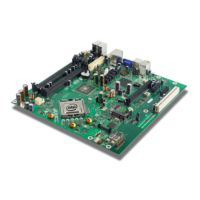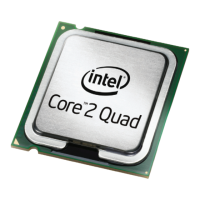Balanced Technology Extended (BTX) Thermal/Mechanical Design Information
Thermal and Mechanical Design Guidelines 43
5.1.5 Altitude
The reference TMA will be evaluated at sea level. However, many companies design
products that must function reliably at high altitude, typically 1,500 m [5,000 ft] or
more. Air-cooled temperature calculations and measurements at sea level must be
adjusted to take into account altitude effects like variation in air density and overall
heat capacity. This often leads to some degradation in thermal solution performance
compared to what is obtained at sea level, with lower fan performance and higher
surface temperatures. The system designer needs to account for altitude effects in the
overall system thermal design to make sure that the T
C
requirement for the processor
is met at the targeted altitude.
5.1.6 Reference Heatsink Thermal Validation
The Intel reference heatsink will be validated within the specific boundary conditions
based on the methodology described Section 5.2 , and using a thermal test vehicle.
Testing is done in a BTX chassis at ambient lab temperature. The test results, for a
number of samples, will be reported in terms of a worst-case mean + 3σ value for
thermal characterization parameter using real processors (based on the thermal test
vehicle correction factors).
5.2 Environmental Reliability Testing
5.2.1 Structural Reliability Testing
Structural reliability tests consist of unpackaged, system -level vibration and shock
tests of a given thermal solution in the assembled state. The thermal solution should
meet the specified thermal performance targets after these tests are conducted;
however, the test conditions outlined here may differ from your own system
requirements.
5.2.1.1 Random Vibration Test Procedure
Recommended performance requirement for a system:
• Duration: 10 min/axis, 3 axes
• Frequency Range: 5 Hz to 500 Hz
5 Hz @ .001 g2/Hz to 20 Hz @ 0.01 g2/Hz (slope up)
20 Hz to 500 Hz @ 0.01 g2/Hz (flat)
• Power Spectral Density (PSD) Profile: 2.2 G RMS

